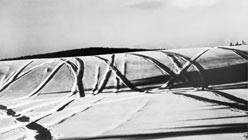Entering Haines Gallery, one is confronted with a wall of text reproduced from Dennis Oppenheim’s sketchbooks in 1968. The phrases read like a series of riddles and were perhaps notes on future works. “Information changes as surface conditions change,” states one entry, a tidy summary of Oppenheim’s unwieldy career in an art world that never quite settled on its opinion of his work. His as-yet unwritten catalogue raisonné is widely conceptual and includes work in performance, video, drawing, sculpture, installation, body art, land art, and public art. Some of the best assessments were summarily offered as obituaries last year when the artist passed away at age 72; this marked the beginnings of a kind of critical hindsight often bestowed on the under-recognized in their absence. Haines Gallery, which has shown Oppenheim’s work for more than twenty years, instigates this overdue conversation with Dennis Oppenheim 1968: Earthworks and Ground Systems, a selection of early works from a watershed moment in the artist’s career and in the land art movement in general.

Born in aptly named Electric City, Washington, while his father worked on the development of the Grand Cooley Dam, Oppenheim later relocated to the Bay Area and was educated at California College of the Arts and Crafts and at Stanford. There is a compelling correlation between his origins at the construction site of a dam, which essentially reshapes the earth, and his later artworks. Most of the work in the gallery comprises photo-documentation from interventionist performances in expansive, isolated landscapes, such as a series of snow tracks cut with a snowmobile in One Hour Run (all works 1968 unless noted), as well as a series of preparatory drawings for various structures. Annual Rings presents documentation from a performance where Oppenheim shoveled a series of rings in the snow, akin to the annual lines of a tree, at the U. S.–Canada border. This work was featured, among others, in his first solo show at age thirty at John Gibson Gallery in New York. Over the next few years, Oppenheim’s work would be included in a number of seminal exhibitions, including Live in Your Head: When Attitudes Become Form, curated by Harold Szeemann, and Earth Art at Cornell University.
A video in the gallery, Back-Track (1969) conveys the artist’s investigational spirit: a grainy 16mm camera is trained on Oppenheim’s upper body as he is presumably dragged along the shoreline at Jones Beach, New York. A mop of curly hair conceals his expression; we see only his arms and hands gathering sand as he is pulled along. When a discarded plank appears on film, we don’t know if he was dragged over it or not — it is just suddenly there, being used as tool. When the film concludes, the vantage point has changed and the camera is trained on the artist’s back. Et voila: The viewer has backtracked and the physical effort of the artist is now a shared experience. The simplicity of the video reflects on the way conceptual art at this time developed as a result of inexpensive, portable media — the gestures were initially basic, though loaded with ideas.



